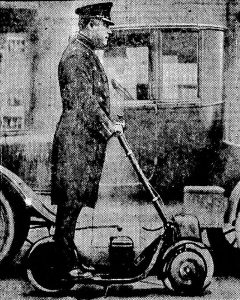History
 According to the Online Bicycle Museum, the Autoped Company is the “true ancestor of the modern scooter”. These devices were quite popular and even adopted by the U.S. Post Office and New York City Police. Their popularity spread and they were licensed in England, Germany and Czechoslovakia. In the more recent past, dockless e-scooters began appearing in US markets in 2017 and by the end of 2018, had reach nearly 100 U.S. Cities. Distribution reached a high of 115 cities in 2019. This rapid expansion proved to be unsustainable, and the number of locations with scooter systems decreased in 2020 to 69 cities.
According to the Online Bicycle Museum, the Autoped Company is the “true ancestor of the modern scooter”. These devices were quite popular and even adopted by the U.S. Post Office and New York City Police. Their popularity spread and they were licensed in England, Germany and Czechoslovakia. In the more recent past, dockless e-scooters began appearing in US markets in 2017 and by the end of 2018, had reach nearly 100 U.S. Cities. Distribution reached a high of 115 cities in 2019. This rapid expansion proved to be unsustainable, and the number of locations with scooter systems decreased in 2020 to 69 cities.
Initially, there was some regulatory confusion. Santa Monica, CA was the one of the first U.S. cities where scooters were deployed without warning. The city responded by filing a misdemeanor criminal complaint against Bird, which claimed that Bird began operating without city approval and ignored citations requiring them to obtain proper licenses and remove the scooters from sidewalks. This was resolved with Bird pleading no contest to the charges and securing the proper business licenses, as well as paying more than $300,000 in fines. While this pattern of deploying without notice, or asking forgiveness rather than permission, was repeated in other cities. In a similar instance San Francisco issued cease and desist letters to Spin, Lime, and Bird in 2018 after receiving a flood of complaints about sidewalk riding and parking and devices being thrown into the San Francisco Bay.
Even prior to the COVID-19 pandemic, e-scooter companies had begun to leave markets, possibly due to excessive competition and other market pressures (NACTO, 2020). Portland reported that in late 2019, e-scooter companies were already being challenged with difficulties in reaching profitability, and responded by reducing their service areas in the city significantly (City of Portland Bureau of Transportation, 2020). Then with COVID-19 there came a 90% drop in overall worldwide mobility demand during the first lockdown, with decreases of 40-70% that continued during the recovery period (May-June 2020) based on Apple Maps data (Van Audenhove et al., 2020). In the U.S., household trips fell 68-72% nationwide, and transit ridership fell 80% from the previous year (NACTO, 2020). Portland reported that in March when the stay-at-home orders were issued, ridership dropped 90% from its pre-pandemic level, with some providers then suspending service altogether (City of Portland Bureau of Transportation, 2020).
%
ridership drop from pre-pandemic level
Even prior to the COVID-19 pandemic, e-scooter companies had begun to leave markets, possibly due to excessive competition and other market pressures. In late 2019, e-scooter companies were already being challenged with difficulties in reaching profitability and responded by reducing their service areas in the city significantly. Then with COVID-19 there came a 90% drop in overall worldwide mobility demand during the first lockdown, with decreases of 40-70% that continued during the recovery period (May-June 2020). In the U.S., household trips fell 68-72% nationwide, and transit ridership fell 80% from the previous year. The Portland Bureau of Transportation reported that in March when the stay-at-home orders were issued, ridership dropped 90% from its pre-pandemic level, with some providers then suspending service altogether. Many of the cities where e-scooter providers were not contractually obligated to operate have paused operations. Micromobility providers suffered large decreases in global revenues and market valuations of many have fallen, and some have had layoffs.
While these statistics seem somewhat grim, COVID has certainly not ended shared micromobility. For instance, New York bikeshare was up 67% in mid-March 2020 compared to the previous year (note that there were no scooters in New York City at that time). Similarly, Chicago’s Divvy bikeshare program reported twice the usage in March 2020 over March 2019. Some cities determined that micromobility was an essential service, and partnered with providers to reduce fares. Additionally, operators in some cities have offered unlimited free rides to essential workers.
Reduced costs may not be the only reason for shared e-scooters to continue to be a viable transportation option. In cities where transit options have decreased, micromobility has increased. For instance, in Detroit, a scooter provider work with the city when they decreased bus routes to ensure scooters would be placed along the closed or reduced bus route sections. And as unemployment claims skyrocket, ensuring the continued availability of low-cost transportation options such as micromobility becomes more important. While many markets have seen reduced e-scooter usage, some areas, including Chicago, Minneapolis, and New York have overturned previous bans.
